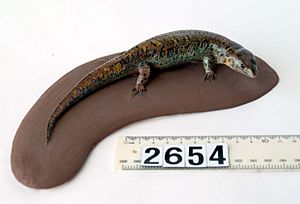Robust skink facts for kids
Quick facts for kids Robust skink |
|
|---|---|
 |
|
| Conservation status | |
| Scientific classification | |
| Genus: |
Oligosoma
|
| Species: |
alani
|
| Synonyms | |
|
|
The robust skink is a special kind of lizard found only in New Zealand. Its scientific name is Oligosoma alani. These skinks are quite large for a lizard and are very rare. They belong to the skink family, called Scincidae. Being "endemic" means they naturally live nowhere else in the world!
Contents
Where Do Robust Skinks Live?
Robust skinks used to live all over New Zealand's North Island. Sadly, most of them were eaten by different kinds of rats that were brought to New Zealand. Because of this, robust skinks are now very rare. Today, you can only find them naturally on six small islands. These islands are located off the north-eastern coast of the North Island.
How the Robust Skink Got Its Name
The scientific name for the robust skink is Oligosoma alani. The second part of its name, alani, was given by the person who first described the species, Joan Robb. She named it in honor of her nephew, Alan Robb.
How Robust Skinks Live and Where They Stay
The robust skink is mostly active at night. This means it is a nocturnal animal. During the day, it likes to hide under rocks, inside burrows made by seabirds, or in old tree stumps and fallen logs. These skinks prefer places with lots of plants and fallen leaves on the ground. They can also live near the coast if there is plenty of thick plant cover.
Scientists have found that robust skinks lose water from their skin very easily. This might be why they prefer damp places. They like to stay in moist spots like cracks in rocks, bird burrows, rotting logs, and thick, matted plants.
Robust Skink Reproduction
Robust skinks are viviparous. This means that the mother skink gives birth to live young. The babies develop inside her body, similar to how mammals do. They do not hatch from eggs laid outside the body.


